Medical Savings Accounts (MSAs) have been available in South Africa for almost a decade. Health insurance plans that utilize MSAs have captured half the market for health insurance there. Individuals use these accounts to pay expenses not paid for by third-party health insurance.
Unlike the United States experience, however, MSAs in South Africa developed in a relatively free health insurance marketplace. As a result, employers and insurers have been able to experiment and innovate to find out what works and what does not. Their experience offers valuable lessons for the United States.
For example, a typical South African MSA plan has a deductible that varies, depending on the type of health care service. In a hospital setting, where patients have little discretion, the deductible is typically zero. But for outpatient care, where patients have considerable discretion, a deductible of, say, $1,100 typically applies. In most cases, the high deductible also applies to drugs. However, in the case of chronic conditions, for which skimping on drugs could lead to more expensive care later, the deductible drops back to zero.
When the behavior of South African families enrolled in conventional insurance plans is compared with those in MSA plans, the results are striking:
- On the average, discretionary spending (primarily outpatient spending) is 47 percent lower for those enrolled in Medical Savings Accounts plans.
- In addition, no evidence suggests that members of MSA plans are shifting costs to a hospital setting where the insurer would foot the entire bill.
In fact, the evidence strongly suggests that MSAs – when designed and used in the right way – are a useful tool for controlling the costs of prescription drugs. We compared the behavior of 76,072 enrollees before and after they reached their deductible for outpatient spending. Before reaching the deductible, claims for prescribed drugs were paid out of the member's MSA. Since patients get to keep any MSA money they do not spend, before reaching the deductible they are spending their own money. Once they reach the deductible, the insurer pays these claims in full. The difference:
- The average cost of a prescription for members increased 7.1 percent after they hit their deductible.
- More dramatically, the average number of prescriptions filled per month grew by 19.1 percent after members exceeded the deductible.
- Overall, the increase in per-member-per-month costs after hitting the threshold was 27.6 percent.
Considering that annual U.S. drug spending is more than $100 billion, these results are a powerful indicator of the potential of MSAs to control U.S. health care costs.
Patients are often more effective and more efficient monitors of prescription drug therapy than are third-party payers, even under a regime of strict managed care. The switch from a brand-name drug to a generic equivalent may affect some patients differently than others. Different dosage levels also have different effects on different patients. No one is in a better position to observe these effects and weigh the costs against the benefits of alternatives than the patients themselves. For example:
- South African patients spending from their own MSAs reduced spending on Ritalin (for children with attention deficit disorder) by almost 20 percent compared to their spending under a managed care arrangement, without any adverse health affects.
- Patients using their MSAs also were much more likely to purchase a generic equivalent that cost only 38 percent as much as Prozac (for depression); by contrast, use of the brand-name drug jumped 45 percent when patients were spending insurance company money.
In both these examples, patients with MSAs controlled costs as well or better than managed care – without the costs associated with managed care.
Some MSA critics contend that the introduction of deductibles might induce members to forgo necessary care in order to save money. To test this proposition, we examined the use of two drugs (Fosamax and Trisequens) used primarily for the prevention and treatment of osteoporosis in postmenopausal women. Patients used some of their MSA funds to buy these drugs in 1999, but switched to managed care the following year so the insurer bore the entire cost of the drugs. Here, the results are quite different from the case of Ritalin. The amounts spent using MSAs are almost indistinguishable from those under the chronic benefit, providing convincing evidence that members were not forgoing necessary care.
[page]Under the regime of Nelson Mandela in the 1990s, South Africa conducted a unique experiment in the market for private health insurance. After deregulation in 1994, virtually every type of health insurance plan sold in the United States was able to enter the South African market – from health maintenance organizations (HMOs) to preferred provider organizations (PPOs) to Medical Savings Account plans (MSAs). And after a favorable ruling from the tax authorities, employer deposits to MSAs received the same tax treatment as employer payment of third-party insurance premiums. Employees were free to use their MSA funds to pay expenses not paid by third-party insurance.
"In South Africa, Medical Savings Account (MSA) plans have captured half the market for private insurance."
Thus in South Africa, MSA plans have competed against other forms of insurance on a level playing field for several years. The result has been remarkable. From a zero base in 1994, MSAs have to date captured about half of the private health insurance market (which covers approximately 7 million people). By contrast, HMO-type managed care has made only small inroads. In addition, both average costs and annual increases under MSAs have been significantly lower than under conventional health insurance plans. The overall success of MSA plans in South Africa provides compelling evidence of their attractiveness to both employer groups and individual consumers.
This document evaluates the evidence for the effectiveness of MSAs in ensuring affordable and sustainable care by examining five areas of expenditure:
- Overall prescription drug spending,
- Spending on discretionary outpatient services,
- Spending on discretionary drugs and their generic equivalents, and
- Spending on nondiscretionary drugs.
"MSA patients reduce spending on discretionary items, without any adverse effects on their health."
It makes the case that MSAs, by creating the correct incentives, can ensure that discretionary costs remain under control. At the same time, it clearly shows that MSA plan members do not forgo preventive care that is in their long-term interest.
[page]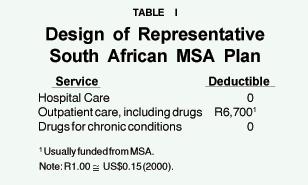
In the United States, the design of tax-free MSA plans allowed under a special pilot program is rigidly defined in the tax code. In South Africa, insurers have been free to innovate and experiment. The result is a far more interesting product – one better designed to meet customer needs.
"Deductibles vary – giving patents economic inventives where incentives make sense."
Whereas a U.S.-type MSA plan has an across-the-board deductible covering all medical services, South African MSA plans typically have varying deductibles. For example, a representative plan has no deductible for hospital care on the theory that patients exercise little discretion within hospitals, but an $1,100 deductible for annual outpatient care on the theory that patients have far more discretion in that setting. The high deductible also applies to prescription drugs. However, for chronic conditions, for which skimping on medication could lead to more expensive care later on, the deductible drops back to zero.1 [See Table I.]
"Below the deductible, patients are spending their own money; above the deductible, they are spending insurance company money."
Controlling the Cost of Discretionary Spending. Table II shows the results of a study based on 61,760 South African families enrolled in conventional insurance plans and MSA plans. The results are striking. On the average, discretionary expenditure (primarily outpatient spending) was 47 percent lower for those enrolled in Medical Savings Accounts plans, with even higher reductions among older enrollees. No evidence suggested that members of MSA plans were shifting costs to a hospital setting where the insurer would foot the whole bill.
The coverage MSAs offer consumers and their ability to control employers' costs make them popular. In what follows, we investigate in more detail the ways in which the MSA encourages healthy behavior from health plan members, while keeping the costs of medical care under control.
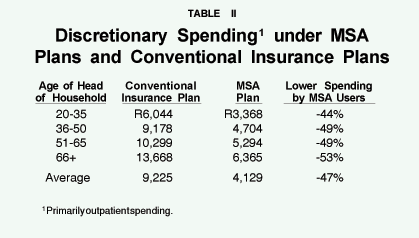
"Afters MSA patients reached their deductible, their monthly spending on drugs increased by 27.6 percent."
Controlling the Cost of Prescribed Medication. Drug spending forms a large and constantly growing part of the cost of medical care. In the South African private sector, more than 25 percent of all health spending is on drugs, with an increase in real terms of 21 percent from 1997 to 2000.2 In the United States, 8.2 percent of spending is on prescription drugs, with nominal increases of 13.4 percent and 16.9 percent in 1998 and 1999 respectively.3 Although prescription drugs may help lower the cost of alternative therapies (e.g., doctor therapy and hospital therapy), the high and rising cost of drugs contributes to medical inflation and, in turn, to increases in health insurance premiums. Keeping drug costs under control while continuing to provide quality care is the challenge faced by all in the health sector.
"Patients are often more effective and efficient monitors of drug therapy than third-party payers."
The experience of Discovery Health in South Africa provides convincing evidence that MSAs – when designed and used in the right way – can be an exceptionally useful tool in this battle. In 2000, of the 202,595 Discovery members who were active for the whole year, 76,072 (or 37.5 percent) reached their deductible for outpatient spending. Before reaching the deductible, claims for prescribed drugs (not including drugs for specified chronic conditions) were paid out of the member's MSA. Any money remaining in the MSA at the end of the year belongs to the member and can be used to cover costs in the following year. Members are essentially spending their own money below the deductible and therefore have an incentive to spend wisely. Once the member's costs reach the deductible, the insurer pays the entire cost of any claims.
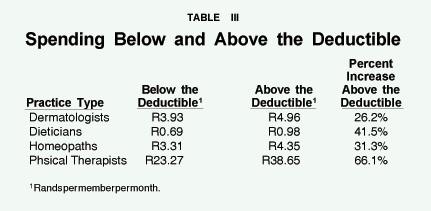
This plan design enables investigation of the effects of MSAs on the cost of medication. Examining only the members who actually hit their deductibles in 2000, we find that:
- The average cost of a prescription for members before they hit their deductible was R85.10 (US$12.25). For exactly the same members, the average cost after hitting the deductible was R91.18 (US$13.13), an increase of 7.1 percent.
- More dramatically, the average number of prescriptions filled per month grew from 2.97 below the deductible to 3.54 after hitting the threshold, an increase of 19.1 percent.
- The overall growth in per-member-per-month costs after members crossed the threshold was 27.6 percent.
Considering that annual U.S. drug spending is more than $100 billion, the South African results are a powerful indicator of the potential value of MSAs in managing drug expenditures in the United States.
"Discretionary spending was 47 percent lower under MSA plans."
Controlling the Use of Discretionary Services. Certain medical and drug expenses clearly rely more on discretion than others. Physical therapy, dermatology and homeopathy are some of the clearer examples of relatively discretionary services. It is here that MSAs have some of their most powerful and most useful affects. If MSAs are performing their intended function, members should spend less on these optional treatments when they are below their deductibles (and hence spending their own money) than when they are above (and hence spending insurance company money).
Looking again only at the members who hit their thresholds in 2000, we find distinct differences in discretionary spending, as shown in Table III:
- Once the deductible had been reached, spending per person per month increased by 26.2 percent for dermatologists, 41.5 percent for dieticians, 31.3 percent for homeopathy and a massive 66.1 percent for physical therapists.
- Overall, claims increased by 33.3 percent per member per month after the deductible was reached.
These figures show conclusively that when members have the right incentives to spend their money wisely, they are likely to spend substantially less on discretionary services.
[page]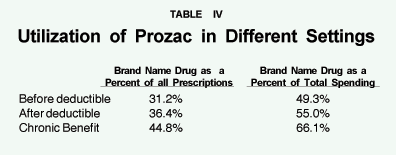
"MSA patients control costs better than managed care, but without the costs of managed care."
Patients are often more effective and more efficient monitors of prescription drug therapy than third-party payers, even under a regime of strict managed care. The switch from a brand-name drug to a generic equivalent may affect some patients differently than others. Different dosage levels also have different effects on different patients. No one is in a better position to observe these effects and weigh the costs against the benefits of alternatives than are the patients themselves.
Case Study: Prozac. An analysis of the patterns of Discovery members' usage of Prozac and its generic equivalents shows the value of MSAs in encouraging members to consider shifting to generics. In South Africa, the retail price for a pack of 30 Prozac 20mg capsules is approximately R298 (US$42.90). Generic equivalents retail at approximately R112 (US$16), or 38 percent of the cost of the brand name drug. From a detailed analysis of the 76,072 Discovery members who hit their deductibles in 2000, we discover that people using an MSA were more likely to switch to generics:
- 4,494 families had at least one member using Prozac or a generic equivalent in 2000, with an annual expenditure of R7.214 million (US$1.03 million).
- When these members were below their deductibles -paying for their own medicines – Prozac accounted for 31.2 percent of the prescriptions and 49.3 percent of the amount spent.
- Above the deductible, when the insurer was paying, the use of the brand-name drug increased to 36.4 percent of the prescription and 55 percent of the amount spent.
- This represents a 16.6 percent increase in utilization of the more expensive drug once people exceeded their deductibles.
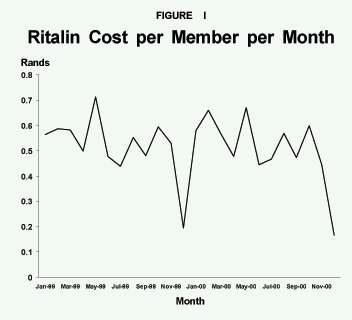
Other evidence of the MSAs' impact is no less striking. Prozac is also covered for some members under Discovery's tightly managed Chronic Illness Benefit (CIB), which involves clinical registration criteria, an ongoing drug utilization review and contracts with several providers of prescription drugs. This benefit has no deductible, since spending on drugs for members with chronic conditions is essential to avoid more serious complications and hospitalizations.
Under this benefit, 44.8 percent of the utilization and 66.1 percent of the expenditure is on the brand-name drug. This represents a 43 percent increase in usage when members are using insurance company money rather than their own. The results of this comparison, summarized in Table IV, show that patients using MSAs are better at managing drug costs than are managed care plans.
"Patients are more likely to choose a cheaper, generic equivalent when they are spending from their MSA."
Case Study: Ritalin. Ritalin is widely prescribed for children with Attention Deficit Hyperactivity Disorder (ADHD). However, many physicians and consumers contend that Ritalin may be overused. Figure I shows the amount spent on the drug (per member per month) by Discovery members in 1999 and 2000. The distinct seasonality – with substantial dips in usage during the school holiday months of April, June/July, September and December – suggests strongly that there is considerable discretion over the use of Ritalin in this population.
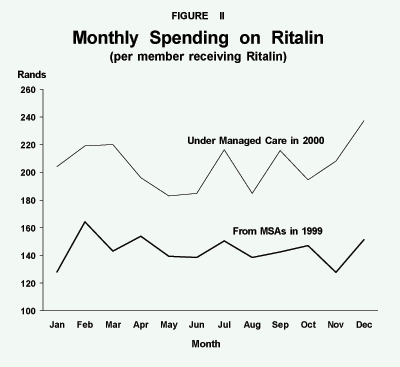
"Ritalin is widely prescribed for children with Attention Deficit Disorder (ADHD)."
In January 2000, a change in the design of Discovery's insurance product allowed Ritalin to be covered with no deductible if the member registered for the company's Chronic Illness Benefit (CIB) described earlier. Previously, the member had paid for the drug with MSA funds until he or she reached the deductible. The design change enabled a natural experiment that illustrates the changes in member behavior when discretionary items are covered in an MSA or in a fully insured, tightly managed care environment.
Since the choice of whether to apply for the chronic benefit relied on the member's initiative, those who moved to the chronic plan (with no deductible) were more likely to be the higher claimers. By the end of 2000, a substantial proportion of members were still paying for the drug from the MSA, reflecting either ineligibility for the chronic benefit or, more commonly, the fact that the member had not tried to register. For this reason, Discovery restricted its analysis to those members who moved to the chronic benefit before the end of 2000.
The results of the comparison are striking. Figure II shows the average cost per member to Discovery under the chronic benefit (managed care), compared with the average amounts paid from Medical Savings Accounts by those same patients one year earlier.
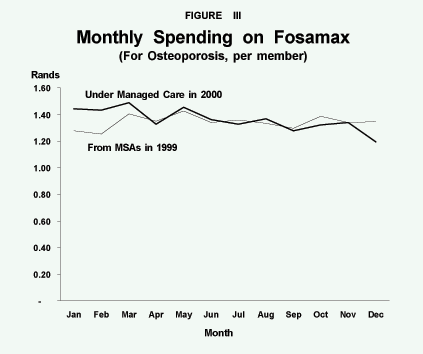
Several trends are clear:
- The average costs of Ritalin claims paid from MSAs have remained stable, at an average of R155.87 (US$22.44) (despite a small bump in November 2000).
- On the average, MSA claims paid are R39.76 (US$5.72) lower than chronic claims, almost a 20 percent reduction.4
Thus the MSA performs the same function as a costly, tightly managed, restrictive program at very little cost and with minimal hassle. The CIB management involves administrators, nurses and a call center, all of which are superfluous when members have a stake in their own discretionary spending.
"MSA patients spent 20 percent less on Ritalin than those same families spent under managed care."
Case Study: Postmenopausal Drugs. Some MSA critics contend that the introduction of deductibles might induce members to forgo necessary care in order to save money. The implication is that when members are paying for their own care, they might skimp on preventive treatment at the expense of their future health. The experience of Discovery's enrollees shows that this contention is simply untrue.
"Where patients believe a drug is necessary, there is no difference bet-ween spending from an MSA ans spending under managed care."
The January 2000 product change also shifted several prescription drugs used during and after menopause from the MSA to the CIB. Two of these drugs, Fosamax and Trisequens, are used primarily for the prevention and treatment of osteoporosis in postmenopausal women, with the latter being widely used for hormone replacement therapy. Discovery's product design change presented an opportunity to evaluate whether members in the MSA environment were forgoing necessary preventive care to save money, with the potential for more serious (and costly) damage occurring later.
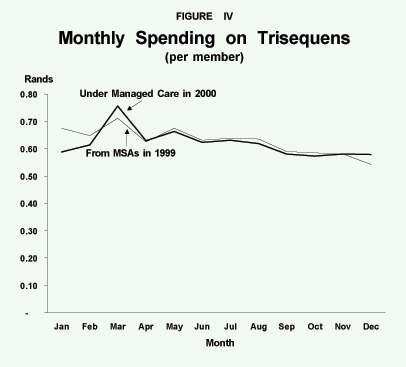
The analysis was identical to that performed for Ritalin. Figures III and IV show the per-member-per-month costs for Fosamax and Trisequens respectively from January 1999 to December 2000, including a breakdown for the amount spent from the chronic benefit and from the MSA plan, respectively. The overall level did not increase with the introduction of complete coverage with no deductible, suggesting that MSAs were not keeping expenditure on the drugs artificially low. The relatively stable levels of overall expenditure are consistent with the nondiscretionary nature of the drugs.
"Fosamax and Trisequens are used to prevent and treat osteoporosis in postmenopausal women."
To ensure that members' health status did not cloud the results, the detailed data were once again restricted to those members who switched from the MSA to the chronic benefit before the end of December 2000. Thus, Figures III and IV compare spending by the patients over the two-year period – from an MSA in 1999 and under managed care in 2000.
"The evidence is compelling: MSA patients are able to control the cost of prescription drugs with no adverse effects on their health."
Here, the results are quite different from those with Ritalin. The amounts spent using MSAs are almost indistinguishable from those under the chronic benefit, providing convincing evidence that members are not forgoing necessary care. Even when members have no direct incentive to control their costs, they do not claim more of these particular drugs than under the MSA benefit. When the extra costs of managing the chronic benefit are considered, the value of the self-containing nature of MSA expenditure becomes obvious.
This is conclusive evidence that members are willing to spend their own MSA money on preventive and necessary care, knowing that to do so is in the best interests of their long-term health.
[page]The evidence presented above is compelling. With carefully designed MSAs, people are more likely to:
- Spend less on prescription drugs,
- Use generic equivalents of branded drugs, and
- Contain their own costs on discretionary items while not skimping on necessary medical care.
"Patients do not skimp on care that is necessary for their future health."
The astounding growth of MSAs in South Africa is the clearest endorsement of the success of these products. When Medical Savings Account plans are based on both extensive clinical knowledge and experience of utilization patterns, they are the most appropriate and sustainable way of financing private health care.
NOTE: Nothing written here should be construed as necessarily reflecting the views of the National Center for Policy Analysis or as an attempt to aid or hinder the passage of any bill before Congress.
[page]- For more detail on the typical design of South African MSA plans, see Shaun Matisonn, "Medical Savings Accounts in South Africa," NCPA Policy Report No. 234, June 2000, National Center for Policy Analysis (available at www.ncpathinktank.org/pub/st234).
- Andy Gray and Thulani Matsebula (2000), "Drug Pricing" in South African Health Review 2000, Health Systems Trust (available at http://www.hst.org.za/sahr/2000/chapter9.htm).
- Figures are taken from HCFA (http://www.hcfa.gov/stats/nhe-oact/tables/t1.htm).
- This difference is statistically significant at a 0.1 percent level.
Shaun Matisonn was admitted as a Fellow of the Faculty of Actuaries, Edinburgh, and a Fellow of the Actuarial Society of South Africa in 1996 and in 1997 as an associate of the Society of Actuaries, USA. He matriculated from Hyde Park High School in 1989 and holds a Bachelor of Science degree in Mathematical Statistics and Actuarial Science from the University of Witwatersrand.
He is currently Executive Vice President of Discovery Health. He has published papers on modeling health care reform and on various health care systems, as well as case studies for the Harvard Business School.